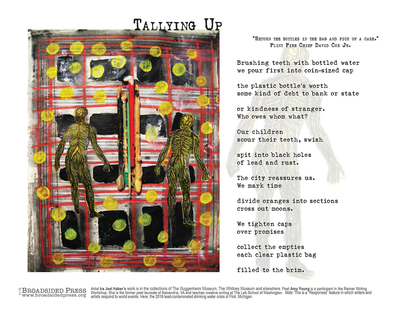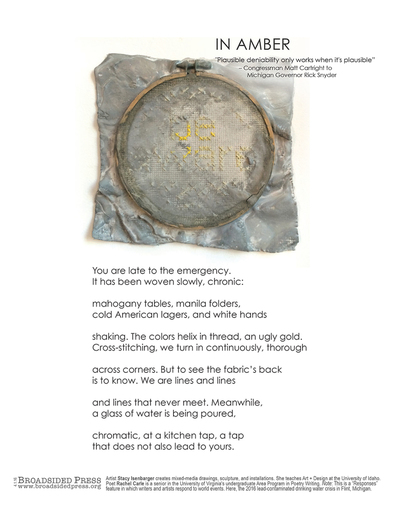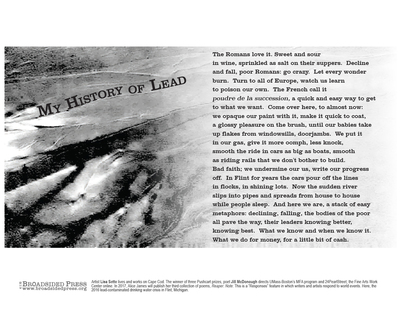Counterforce in the World: Broadsided Press responds to the Flint, MI, water crisis

Tallying Up. Poem by Amy Young, art by Ira Joel Haber, a Responses feature from Broadsided Press.
By Susan Rand Brown
Poet and naturalist Elizabeth Bradfield has lived on the Outer Cape for several decades though her focus has long been global. She came of age aware of our interconnected eco-systems and opened doors through poems published with ink and paper and, for the past decade, through Broadsided Press—an innovative and public-spirited literary project that combines poems with visual art. A new edition, consisting of a single poem visually embedded in an artwork, is posted monthly, and editions from 2005 are archived on an easily navigated website.
While distribution is paperless and mostly achieved using crowd sourcing, readers are also encouraged to distribute content the old-fashioned way. (The term “broadside” was familiar in Shakespeare’s age, when all manner of information was publicly posted.)
Writing is selected from open submissions, and once a poem or flash-fiction is chosen for publication by the editors, it is forwarded to the publication’s pool of thirty-six contributing artists, working in diverse mediums: painting, sculpture, design and photography. One of the artists then creates a visual response, resulting in a collaboration of two art forms merging into a single broadside.

In Amber. Poem by Rachel Carle, art by Stacy Isenbarger, a Responses feature from Broadsided Press.
Periodically, the Broadsided Press editorial team feels strongly enough about a social issue that the traditional format expands to include more than a single broadside. Then, a “Responses” feature is launched. The lead-contaminated water in Flint, Michigan prompted a trio of broadsides: in this case images were chosen first, followed by responsive poems. “There was a deep upwelling of work for this feature—poems about the body, about systemic wrongs, about history and hydration, and poems that played with the elemental nature of lead, the stuff of flint. Our decision was not easy,” Bradfield writes on the website.

My History of Lead. poem by Jill McDonough, art by Lisa Sette, a Responses feature from Broadsided Press
In My History of Lead, Lisa Sette’s imagery evokes dark stains running through liquid. It is coupled with an equally dark poem by Jill McDonough: “Now the sudden river / slips into pipes and spreads from house to house / while people sleep. And here we are, a stack of easy / metaphors: declining, falling, the bodies of the poor / all pave the way.” Equally chilling is In Amber, a multi-media sampler by Stacy Isenbarger, its stains a symbol of a once genteel home now blemished with lead, paired with a poem by Rachel Carle which incorporates words like cross-stitching, thread and fabric. Ira Joel Haber’s Tallying Up–a mixed-media collage where twin figures are depicted as medical textbook drawings of the nervous system–is paired with Amy Young’s furious dismay at the city-sanctioned dismissal of its low-income residents: “The city reassures us. / We mark time / Divide oranges into sections /cross out moons. / We tighten caps / over promises.” That these highly accomplished Broadsided writers and artists have entered the spirit of this contemporary journal affirm that ours is a time worth witnessing. “This is a labor of love,” Bradfield writes, “and an important counterforce in the world. What we do here is part of a larger effort to put poems and art in our daily lives.”
